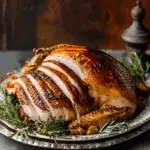Why You’ll Love Roasted Turkey Breast Recipe
This recipe is smaller‑scale and very approachable for anyone who loves turkey but doesn’t want to deal with a huge roast. It’s flavorful thanks to an herb‑butter rub under the skin, and it delivers moist, tender slices without requiring brining or frequent basting.
Ingredients
(Tip: You’ll find the full list of ingredients and measurements in the recipe card below.)
-
1 whole or half bone‑in turkey breast (or boneless)
-
Herb butter:
-
½ cup unsalted butter, softened
-
½ teaspoon salt
-
¼ teaspoon freshly ground black pepper
-
3 cloves garlic, minced
-
1½ teaspoons fresh thyme, chopped
-
1½ teaspoons fresh rosemary, chopped
-
½ teaspoon fresh sage, chopped
-
Directions
-
Thaw the turkey completely if frozen (follow safe thawing guidelines). Remove it from the fridge about 20 minutes before cooking.
-
Preheat your oven to 325 °F (about 163 °C).
-
Combine the butter, garlic, salt, pepper, and herbs to make the herb butter.
-
Pat the turkey breast dry on all sides. Season the outside with salt and pepper.
-
Loosen the skin over the turkey breast and spread a spoonful of herb butter under the skin, over both sides of the breast. Then spread the remaining herb butter over the outside of the turkey breast. Place the turkey in a baking dish or sheet pan.
-
Roast in the center of the oven at 325 °F for about 14‑15 minutes per pound, or until the internal temperature in the thickest part reaches 165 °F (about 74 °C). It’s okay to remove it just a bit shy of 165°F since it will continue cooking as it rests.
-
Remove the turkey from the oven and cover loosely with aluminum foil. Let it rest for at least 15 minutes before carving, so the juices redistribute.
Servings and timing
-
Servings: 5
-
Prep time: 30 minutes
-
Cook time: 1 hour
-
Resting time: 15 minutes
-
Total time: about 1 hour 45 minutes
Variations
-
Use a boneless turkey breast if you prefer easier slicing or quicker cook time—just adjust timing accordingly.
-
Substitute dried herbs if you don’t have fresh thyme, rosemary, or sage; reduce quantities by about one‑third.
-
Add other flavorings to the herb butter like lemon zest, smoked paprika, or a splash of white wine for a more layered taste.
-
For a crispier skin, after the initial roasting you can increase oven temperature to ~425 °F (218 °C) for the last 10 minutes, watching carefully to avoid burning.
-
Try serving with different sauces: a pan gravy, cranberry relish, or a mustard‑herb sauce for contrast.
Storage/Reheating
-
Store any leftover turkey breast in an airtight container in the fridge for up to 3‑4 days.
-
To reheat, slice the turkey and place in a baking dish with a splash of broth or water, cover tightly with foil, and warm in a 325 °F (163 °C) oven for about 15‑20 minutes, until gently heated through.
-
For freezer storage, wrap the cooled turkey pieces tightly in plastic wrap and/or foil, then place in a freezer bag. Freeze for up to 2‑3 months. Thaw in the fridge overnight before reheating.
-
To help retain moisture, reheat gently and avoid drying it out by adding a little liquid and using covered baking.
FAQs
What size turkey breast should I use?
Choose a size that fits how many servings you need. The recipe is scaled to feed about 5 people. A half breast or a smaller bone‑in breast will work nicely. Adjust cooking time based on weight.
Do I need to brine the turkey breast?
No, this recipe skips brining and instead uses seasoned herb butter under the skin to deliver flavor and moisture.
Can I use boneless instead of bone‑in turkey breast?
Yes. Boneless will cook a bit faster and may be easier to slice, just monitor internal temperature and adjust time accordingly.
How do I know when the turkey breast is done?
Use a meat thermometer and check the internal temperature in the thickest part of the breast—it should reach 165 °F (about 74 °C). Then allow it to rest before carving.
Can I roast at a higher temperature?
Yes, but this slower 325 °F method helps ensure even cooking and reduces risk of drying. If you increase temperature, watch carefully to prevent overcooking.
How thick should I spread the herb butter under the skin?
A generous layer is best—loosen the skin and spread as much as you can over the meat itself, then rub the remainder on the outside skin. This helps flavor and moisture.
What should I serve with roasted turkey breast?
Classic sides like mashed potatoes, rolls, stuffing, roasted vegetables, or a crisp salad all work well. Leftover turkey makes great sandwiches or wraps.
Can I prepare this ahead of time?
You can prepare the herb butter and season the turkey a few hours ahead, then refrigerate until ready to roast. Let it come to room temp for 20 minutes before cooking.
How do I carve a turkey breast?
After resting, place turkey on a cutting board. Use a sharp slicing knife and slice against the grain into even slices. A bone‑in breast may require removing the skin and slicing around the bone.
Will the turkey breast dry out if I leave it too long in the oven?
Potentially yes—overcooking is the main cause of dryness. Using the internal temperature method and giving a proper rest after roasting will help keep it moist and flavorful.
Conclusion
This roasted turkey breast recipe offers a simpler way to enjoy the rich, comforting flavor of turkey without the logistics of a full bird. With minimal fuss, tender meat, and plenty of savory herb butter under the skin, it’s a reliable go‑to for holiday dinners, family meals, or any time you want something special. Slice it, serve it with your favorite sides, and enjoy the ease of a beautifully cooked turkey breast.
Roasted Turkey Breast
5 Stars 4 Stars 3 Stars 2 Stars 1 Star
No reviews
This Roasted Turkey Breast recipe delivers tender, juicy meat with a crispy, flavorful skin. It’s perfect for smaller gatherings or when you want a quicker alternative to a whole turkey.
- Author: Emily
- Prep Time: 15 minutes
- Cook Time: 2 hours
- Total Time: 2 hours 15 minutes
- Yield: 6-8 servings
- Category: Main Course
- Method: Roasting
- Cuisine: American
- Diet: Gluten Free
Ingredients
- 1 bone-in, skin-on turkey breast (5–7 pounds)
- 4 tablespoons unsalted butter, softened
- 1 teaspoon salt
- ½ teaspoon black pepper
- 1 teaspoon garlic powder
- 1 teaspoon onion powder
- 1 teaspoon paprika
- 1 tablespoon fresh rosemary, chopped
- 1 tablespoon fresh thyme leaves
- 1 tablespoon olive oil
- 1 onion, quartered
- 2 celery stalks, chopped
- 2 carrots, chopped
- 1 cup chicken broth
Instructions
- Preheat oven to 325°F (163°C).
- Pat the turkey breast dry with paper towels and place it in a roasting pan on a bed of chopped onion, celery, and carrots.
- In a small bowl, mix butter, salt, pepper, garlic powder, onion powder, paprika, rosemary, and thyme.
- Loosen the skin of the turkey breast and rub half of the butter mixture under the skin. Rub the remaining mixture on top of the skin and drizzle with olive oil.
- Pour chicken broth into the bottom of the roasting pan.
- Roast uncovered for about 1 hour 45 minutes to 2 hours 15 minutes, or until internal temperature reaches 165°F (74°C).
- Baste occasionally with pan juices during cooking for extra moisture and flavor.
- Remove from oven and tent with foil. Let rest for 15-20 minutes before slicing.
Notes
- Use a meat thermometer to ensure accurate internal temperature.
- Letting the turkey rest before slicing helps retain its juices.
- You can use pan drippings to make homemade gravy.
Nutrition
- Serving Size: 1 serving
- Calories: 400
- Sugar: 1g
- Sodium: 500mg
- Fat: 22g
- Saturated Fat: 8g
- Unsaturated Fat: 12g
- Trans Fat: 0g
- Carbohydrates: 2g
- Fiber: 0g
- Protein: 45g
- Cholesterol: 140mg



